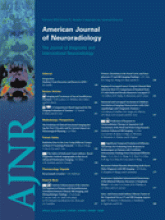Abstract
BACKGROUND AND PURPOSE: The DTI parameters (FA and ADC) reflect the properties of the brain microstructure. Decreased anisotropy is a common feature of cerebral tissue abnormalities. Our study investigates the neurologic prognostic efficiency of these parameters in white (PLIC, CP) and gray matter (PP) in the first days of life in term neonates with HIE. We hypothesize that lesions in related brain areas could be part of a physiopathologic substratum supporting neurologic deficiencies in this population.
MATERIALS AND METHODS: A total of 22 neonates (13 girls and 9 boys; mean gestational age, 40 weeks ± 9 days; birth weight, 3203 ± 584 g) underwent brain MR imaging between day 1 and day 6 after birth; 6–noncollinear direction DTI was performed. FA and ADC were measured on specific brain areas. Amiel-Tison score was performed on day 8.5 ± 4 (group A, favorable outcome [n = 16]; group B, unfavorable outcome [n = 6]).
RESULTS: Intraobserver and interobserver comparison in DTI parameter measurements showed a coefficient of variability of less than 5%. In PLIC and PP, the ADC values were lower in group B compared with group A (P = .000027), whereas in PLIC and CP, the FA values were lower in group B compared with group A (P < .02).
CONCLUSIONS: These findings indicate that a poor early neurologic outcome in neonates with HIE is associated with lower FA or ADC values in specific areas of white or gray matter. The difference in ADC/FA changes in the different brain areas explored may support possibly different pathologic processes.
Abbreviations
- ADC
- apparent diffusion coefficient
- AS
- Apgar score at birth/5 minutes
- BW
- birth weight
- CA
- cardiac arrest
- CP
- cerebral peduncles
- CS
- cesarean section
- CV
- coefficient of variability
- D
- delivery
- DTI
- diffusion tensor imaging
- DWI
- diffusion-weighted imaging
- E
- epinephrine
- FA
- fractional anisotropy
- FHRA
- fetal heart rate abnormalities
- GA
- gestational age
- HI
- hypoxia-ischemia
- HIE
- hypoxic-ischemic encephalopathy
- IE
- instrumental extraction
- IUGR
- intrauterine growth retardation
- MRI
- MR imaging
- MSL
- meconium-stained liquor
- Nl
- normal
- NC
- nuchal cord
- ND
- not done
- PLIC
- posterior limb of internal capsule
- PP
- putamen/pallidum
- S
- seizures
- SE
- status epilepticus
- SS
- Sarnat Score
- T1WI
- T1-weighted imaging
- T2WI
- T2-weighted imaging
- T
- thalamus.
- Copyright © American Society of Neuroradiology












